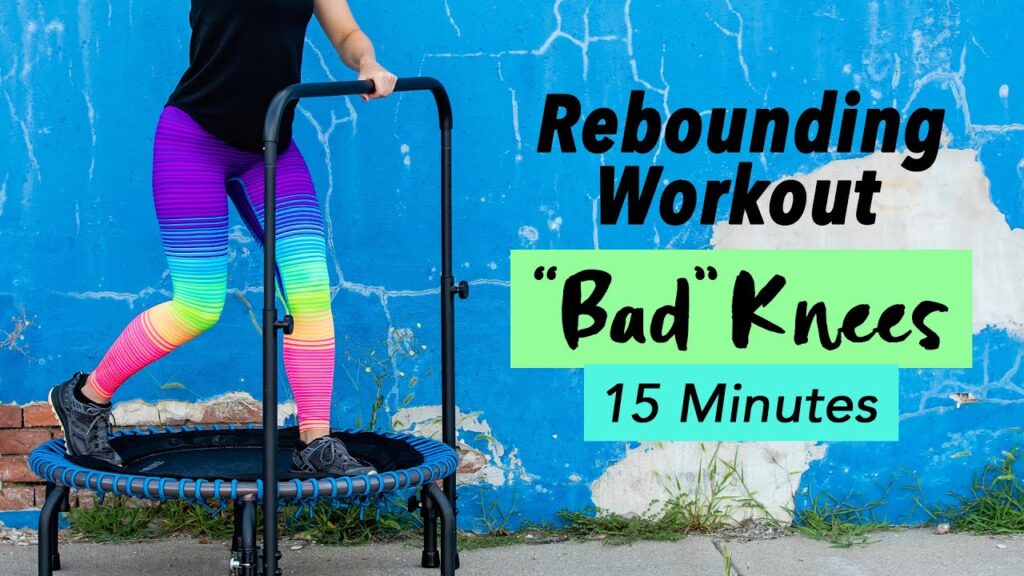Rebounding, or mini-trampoline exercise, has potential drawbacks including joint pain and vertigo. Excessive use may also lead to muscle strain and increased injury risk.
Rebounding has surged in popularity as a low-impact exercise that promises fun and fitness. Yet, not all that bounces is beneficial. Engaging in this form of workout can sometimes bring unexpected negative effects, particularly if done improperly or excessively. It’s crucial for individuals to consider their own health status and consult with a healthcare provider, especially if they have pre-existing conditions or concerns that could be exacerbated by rebounding.
With the popularity of at-home workouts on the rise, rebounding enthusiasts should be aware of the potential pitfalls. This includes recognizing when to modify or avoid certain movements to prevent adverse health outcomes. Safety should always take precedence to ensure that the pursuit of fitness doesn’t come at the cost of wellbeing.

Credit: www.pinterest.com
Introduction To Rebounding
Imagine jumping into fitness with fun and ease. Rebounding is that leap! This exercise uses mini-trampolines for a full-body workout. Unlike traditional workouts, it’s gentle on the joints yet effective in boosting fitness. Rebounding has gained a spotlight in the realm of health enthusiasts.
Popularity Of Mini-trampolines
Mini-trampolines now grace many homes and gyms. They are popular for their convenience and effectiveness. People love them for cardio, balance, and core exercises. Their appeal stretches across ages and fitness levels.
- Easy to fit in small spaces
- Affordable compared to heavy gym equipment
- Fun way to engage in daily workouts
The Concept Of Rebounding
At its core, rebounding is bouncing on a mini-trampoline. This low-impact workout entails various movements. From light jumps to intense sprints, rebounding covers it all.
| Benefits | Activities |
|---|---|
| Improves balance | Basic jumps |
| Enhances cardiovascular health | Running in place |
| Strengthens muscles | Dance routines |
Physical Strain And Injuries
Rebounding is a popular low-impact exercise, but it’s not free of risks. Like any physical activity, it can cause strain and injuries. Below we delve into common issues involving joints and muscles.
Risks To Ankle And Knee Joints
Jumping on a trampoline may look fun, but it puts pressure on your joints. The repetitive bouncing motion can lead to:
- Ankle sprains if you land awkwardly
- Knee pain from constant impact
- Joint wear and tear over time
It’s crucial to listen to your body to prevent serious damage. Using stabilizing bars helps, especially for beginners.
Potential For Muscle Strains
Sudden movements on a rebounder can strain muscles. Improper technique or overuse can lead to:
- Pulled muscles, especially in the legs
- Lower back strain from poor posture
- Neck tension from jerky movements
Always warm up before rebounding. This prepares your muscles. Also, focus on maintaining proper form.
Impact On The Cardiovascular System
The Impact on the Cardiovascular System when engaging in rebounding exercises can be significant. Rebounding, or mini-trampoline bouncing, is a low-impact physical activity. It is popular for its many health benefits. Yet, it’s important to consider potential drawbacks, particularly related to heart health.
Excessive Cardiovascular Stress
Quickly increasing the heart rate is a goal of many workouts. But with rebounding, there’s a risk of adding too much stress. This is especially true for beginners or those not regularly active.
- Blood pressure may spike
- Risk of irregular heartbeat increases
- Dizziness or shortness of breath can occur
Pre-existing Heart Condition Concerns
For individuals with undetected or existing heart conditions, rebounding poses special risks:
| Heart Condition | Risks |
|---|---|
| Cardiomyopathy | Potential for worsened symptoms |
| Coronary artery disease | Increased chance of heart attack |
| Hypertension | Risk of stroke or heart failure |
Vertigo And Balance Problems
Rebounding, or mini-trampoline exercise, offers many health benefits. Yet, certain side effects warrant attention. One area to consider involves vertigo and balance. These experiences can range from mild to severe. Understanding them is essential for safe rebounding practices.
Risk Of Dizziness During Rebounding
Dizziness can occur during rebounding exercises. The motion of bouncing up and down may disrupt the inner ear. This part of the ear is crucial for maintaining balance. Quickly changing directions can cause disorientation and vertigo.
To minimize risk, ensure gradual progression in intensity. A slow start allows the body to adjust to the new movements. Focus on steady, controlled bouncing. Sudden stops or erratic jumps can increase dizziness risk. Always listen to your body and stop if dizziness occurs.
Balance Issues Post-exercise
Post-exercise, some may experience balance concerns. The sensation of still bouncing when still, often described as the “trampoline effect,” might persist. This can be disconcerting and affect stability.
- Take time to rest and reorient after a session.
- Engage in grounding exercises like walking or light stretching.
Be cautious if you have a history of balance disorders. Consult with a healthcare provider before starting a rebounding routine. Young children and older adults should take particular care. These groups are more susceptible to falls. A fall can lead to serious injuries.
| Consideration | Tips for Safety |
|---|---|
| Inner ear sensitivity | Start slow, avoid rapid bouncing |
| Post-rebounding balance | Grounding activities post-exercise |
| Risk of falling | Safety measures for vulnerable individuals |
Rebounding With Pre-existing Conditions
Rebounding with Pre-existing Conditions requires careful consideration.
Though rebounding, or jumping on a mini-trampoline, is often celebrated for its health benefits, it can pose certain risks for individuals with specific medical conditions. Like any form of exercise, it’s crucial to know how it could impact your unique health situation.
Complications For Those With Osteoporosis
Osteoporosis, a condition characterized by weakened bones, requires special attention when it comes to rebounding. While gentle bouncing may help some, it poses the risk of fractures for others.
- Bone fragility increases risk of breaks
- Consult with a medical professional before starting
- Consider alternative low-impact exercises
Bone Density And Joint Considerations
Individuals with low bone density or joint disorders should proceed with caution. Rebounding creates impact that may affect vulnerable joints and bones.
| Rebounding Impact | Consideration for Joints and Bones |
|---|---|
| Repetitive stress | Might aggravate joint issues |
| Jumping force | Can impact bone density |
| Balance demands | Fall risk for those with unstable joints |
Overuse And Overtraining
Rebounding can be a fun way to get fit, but like any exercise, it comes with risks if not done properly. The topic of overuse and overtraining in rebounding is critical. Without the right balance, you might face negative side effects. Let’s delve into the importance of varying workouts and recognizing signs of too much rebounding.
Dangers Of Not Varying Workouts
Sticking to the same rebounding routine can lead to problems. The body benefits from different types of movement. Let’s explore why.
- Muscle imbalances: Repeating the same exercise can overwork certain muscles while neglecting others.
- Increased injury risk: Overused muscles and joints are more prone to injury.
- Plateau effect: The body adapts, resulting in decreased fitness gains.
- Mental burnout: The lack of variety can make exercise feel boring and reduce motivation.
Signs Of Rebounding Overuse
Knowing when to take a break is vital. Look for these telltale signs that you may be doing too much rebounding.
- Persistent soreness: Muscles need time to recover. Soreness that doesn’t go away may signal overuse.
- Chronic fatigue: Feeling tired all the time isn’t normal. Your body may need rest.
- Decreased performance: Struggling to rebound as you used to might mean your body needs a break.
- Mood swings: Overtraining can affect your emotions. Feeling cranky or down could be related to excessive rebounding.
- Sleep disturbances: Quality sleep is crucial. If rebounding leaves you tossing and turning, it’s time to reassess.
Evaluating Rebounding For Your Routine
Before leaping onto the rebounding bandwagon, weigh the pros and cons for your personal health. Rebounding, a low-impact exercise performed on a mini-trampoline, offers a fun workout. However, it’s important to understand both the benefits and the potential drawbacks. Let’s explore when it might be time to consult a professional, and how to balance rebounding with other forms of exercise to maximize overall wellness.
When To Consult A Professional
- Existing medical conditions: Chat with your doctor first.
- Joint problems: Concerns about ankles, knees, or hips? A professional’s advice is key.
- Persistent discomfort: Pain should not follow a workout. Seek help if it does.
- Uncertainty: Unsure how to start or continue safely? A trainer can guide you.
Balancing Rebounding With Other Exercises
| Exercise Type | Benefits | Rebounding Balance |
|---|---|---|
| Aerobic | Improves heart health | Combine short rebounding sessions with walks or runs |
| Strength Training | Builds muscle | Alternate days between lifting weights and rebounding |
| Flexibility | Increases range of motion | Stretch before and after rebounding to prevent injury |
| Balance | Enhances stability | Use rebounding to challenge and improve balance safely |

Credit: thegymgoat.com

Credit: m.youtube.com
Frequently Asked Questions On 15 Negative Side Effects Of Rebounding: Is Rebounding Bad?
Can Rebounding Cause Joint Pain?
Rebounding, or mini-trampoline exercises, can sometimes lead to joint pain if done improperly. Overuse or incorrect form during workouts increases the risk of strain on ankles, knees, and hips.
Is Rebounding Safe For Everyone?
Rebounding is generally safe, but caution is advised for individuals with pre-existing health conditions. Consult a doctor before starting a rebounding routine, particularly for those with cardiovascular issues or bone-related diseases.
How Does Rebounding Impact The Spine?
Rebounding may affect the spine by potentially causing compression if used excessively or with poor technique. Proper form and controlled bouncing are crucial to minimize any negative impact on the spinal column.
What Are Common Rebounding Injuries?
Common rebounding injuries include sprains and strains, particularly in the ankles and knees. Proper warm-up and adherence to good technique can help prevent these types of injuries.
Conclusion
Rebounding might seem like a fun way to stay fit, but it’s important to exercise caution. As we’ve seen, the potential for negative side effects—from joint stress to cardiovascular risks—can’t be ignored. Balance is key, so consider these impacts before incorporating rebounding into your fitness routine.
Stay safe, and always consult with a healthcare provider to tailor workouts to your individual needs.


